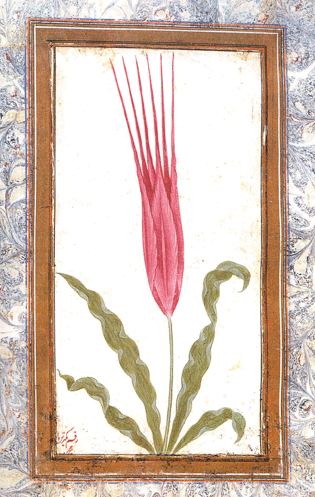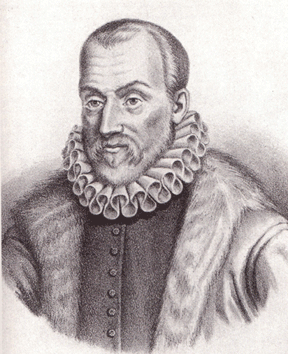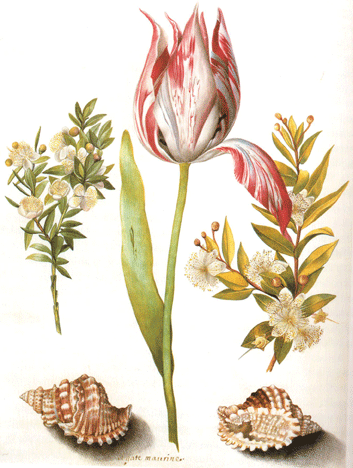
Unnamed tulip from the Turkish ‘The Book of Tulips’, ca. 1725
Webshaykh’s Note: With winter snow buffeting Europe and the Middle East, what better time to think about tulips, an Ottoman treasure that took Europe by storm almost half a millennium ago. There is an excellent book on The Tulip by Anna Pavord (Great Britain: Bloomsbury, 1999), but one of my favorite articles is one that Jon Mandaville wrote for ARAMCO World over three decades ago. The full article is available online, but I provide the first part below.]
Turbans and Tulips
Written by Jon Mandaville. ARAMCO World Magazine, May/June, 1977
Tulips come from Holland. Right? Wrong! Or at least, they haven’t always. Tulips come from Turkey, the only country in the world to call one of its major eras of national history—the years 1700 to 1730—the “Tulip Period.” And how that era got its name . . . thereby hangs a tale.
Tulips, even in the early 18th century, were nothing new to Turkey. Along with other bulbous plants such as the narcissus, the hyacinth and the daffodil, tulips had grown there for centuries, both wild and domesticated for house and garden. The Tulip Period took its name from an established hobby, which started as court fashion, grew into a generalized fad and fancy, and finally became an explosion of unrestrained international speculation in bulbs which buyers never even saw.
It all began when tulips first went to Europe. In 1550, no one in Holland had heard of tulips. Different varieties do grow wild in North Africa and from Greece and Turkey all the way to Afghanistan and Kashmir. Very occasionally they are even found in southern France and Italy, usually in vineyards or on cultivated land, which has led some botanists to speculate that they may have been brought back by the Crusaders.
The Persians were familiar with tulips, but they didn’t domesticate them as thoroughly as the Turks. For centuries they admired the flowers wild. Even as decorative motifs in Persia, they were never as popular as the narcissus, iris or rose.
In Turkey it was different. The Turks cultivated them in flower beds and window boxes and they used the flowers as patterns on textiles and rugs, ceramic tiles, buildings and fountains and even, especially in the case of women, on tombstones. Their name for the tulip was lale, but another Turkish word, dulband, or “turban,” is the origin of our English name, presumedly because of the flower’s shape.
For Ottoman officialdom in 16th-century Istanbul, gardening was a restful hobby, cultivated as a respite from the pressures of the job. Miniature paintings from that century show Turkish gardens to have had an air of relaxed formality. Brick walls defined the borders; four posts marked the corners. On one side a willow or wisteria might be trained up and over a trellis for shade. Stepped terraces of brick or grass embankments led up in the center or at one end to a fountain jetting water into a formal pool. There the Turks planted tulips, marching them in red, yellow and variegated rows along the walkways and up around the fountains.
One of the most notable Turks of the 16th century, the empire’s supreme justice, Ebu es-Suud Effendi, was a gardener and tulip hobbyist. One can imagine him at the end of the day strolling quietly through his gardens beside the dark flowing Bosporus, his long full robes brushing the brick path, draped sleeves flapping gently in the evening air, his hugely wrapped white turban bent down to the rows of small red turbans lifted up beside the paths.
Some evenings he might have been joined by his colleague Sokollu Mehmet Pasha, the Grand Vizier, who also enjoyed gardens. Sokollu Mehmet not only kept a garden of his own near Ebu es-Suud’s, but also had one laid out for his sovereign, Selim II, complete with garden house and tulip beds.

Ogier Ghislain de Busbecq
Then, in 1554, an Austrian with a curious mind and an appreciation of flowers noticed the tulips on his way to Istanbul. He was Ogier Ghislain de Busbecq, Austrian Emperor Ferdinand I’s ambassador to the Sultan at Constantinople. De Busbecq described them in a letter home.
“As we passed, we saw everywhere an abundance of flowers, such as the narcissus, hyacinth and those called by the Turks tulipan, not without great astonishment on account of the time of the year, as it was then the middle of the winter, a season unfriendly to flowers. . . . The tulipan . . . have little or no smell, but are admired for their beauty and variety of color.”
De Busbecq carried seeds back to Vienna and a few years later, in 1559, Konrad Gesner, the Swiss naturalist, saw garden tulips growing at Augsburg, Germany, which he described as having “one large reddish flower, like a red lily.” The picture of a tulip in his gardening book of 1561 is the first known in Europe.

Tulip ‘Agate Maurine’ by Maria Sibylla Merian (1647-1717) Rijksmuseum, Amsterdam
For the rest of this article online, click here.